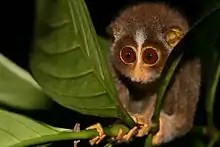Slender loris
The slender lorises (Loris) are a genus of loris native to India and Sri Lanka. Slender lorises spend most of their life in trees, traveling along the top of branches with slow and precise movements. It is found in tropical rainforests, scrub forests, semi-deciduous forests, and swamps. The species have lifespans of 15 years and are nocturnal. Slender lorises generally feed on insects, reptiles, shoots of plants, and fruits.
| Slender lorises | |
|---|---|
 | |
| Red slender loris (Loris tardigradus) | |
| Scientific classification | |
| Kingdom: | Animalia |
| Phylum: | Chordata |
| Class: | Mammalia |
| Order: | Primates |
| Suborder: | Strepsirrhini |
| Family: | Lorisidae |
| Subfamily: | Lorinae |
| Genus: | Loris É. Geoffroy, 1796[2] |
| Type species | |
| Loris tardigradus É. Geoffroy, 1796 | |
| Species | |
| Synonyms | |
| |
Taxonomy

The type species was named Lemur tardigradus by Linnaeus in 1758. The name Loris is first reported Georges-Louis Leclerc, Comte de Buffon in 1765, representing the Dutch loeris meaning "clown". According to Buffon, the name loeris had been in use for some time by Dutch naturalists for the "sloths of ceylon". [3]
The genus Loris was separated from lemurs by Étienne Geoffroy Saint-Hilaire (1796), based on a suggestion of a Lorican genus by Louis-Jean-Marie Daubenton (1792). Saint-Hilaire's Loris at first included Daubenton's type species, Loris de Buffon, which he however delegated to the new Nycticebus genus in 1812.[4]
- Family Lorisidae
- Subfamily Perodicticinae: African lorisids
- Genus Arctocebus: angwantibos
- Genus Perodicticus: the potto
- Genus Pseudopotto: the false potto
- Subfamily Lorisinae: Asian lorisids
- Genus Loris
- Red slender loris, Loris tardigradus
- Gray slender loris, Loris lydekkerianus
- Genus Nycticebus: slow lorises
- Genus Loris
- Subfamily Perodicticinae: African lorisids

In India, slender lorises are known as they are known as devanga-pilli ("దేవాంగ పిల్లి") or arawe-papa in Telugu, kaadu-paapa ("ಕಾಡು ಪಾಪ") in Kannada, and wanur-manushiya in Marathi. In Sri Lanka they are known as unahapuluwa (උනහපුළුවා) in Sinhala, and in Tamil, spoken across southern India and Sri Lanka, they are known as kutti thevangu ("தேவாங்கு" "കുട്ടിതേവാങ്ക്") வா(வாக்கு) விலங்கு(ங்கு)), kattu-papa, Kadapapa, or theivangu (meaning "the slender-bodied one").[5]
Physical characteristics
The red slender loris favors lowland rainforests (up to 700 m in altitude), tropical rainforests and inter-monsoon forests of the south western wet-zone of Sri Lanka. Masmullah Proposed Forest Reserve harbors one of few remaining red slender loris populations, and is considered a biodiversity hotspot. The most common plant species eaten was Humboldtia laurifolia, occurring at 676 trees/ha, with overall density at 1077 trees/ha. H. laurifolia is vulnerable and has a mutualistic relationship with ants, providing abundant food for lorises.[5] Reports from the 1960s suggest that it once also occurred in the coastal zone, however it is now thought to be extinct there.[6]
The red slender loris differ from its close relative the gray slender loris in its frequent use of rapid arboreal locomotion. It forms small social groups, containing adults of both sexes as well as young animals. This species is among the most social of the nocturnal primates. During daylight hours the animals sleep in groups in branch tangles, or curled up on a branch with their heads between their legs. The groups also undertake mutual grooming and play at wrestling. The adults typically hunt separately during the night. They are primarily insectivorous but also eat bird eggs, berries, leaves, buds and occasionally invertebrates as well as geckos and lizards. To maximize protein and nutrient uptake they consume every part of their prey, including the scales and bones. They make nests out of leaves or find hollows of trees or a similar secure place to live in.[6]
Threats
According to biologists, poaching activity has led to the steady decline of the species in Tamil Nadu. Native people have always believed that all parts of the slender loris have some medicinal or magical powers. This has contributed greatly to the decline of the slender loris. In addition, slender lorises are illegally smuggled to supply a growing exotic pet trade. Other threats include habitat loss, electrocution on live wires, and road accidents.[7] Along the western region of Tamil Nadu, there is a vigorous clampdown on illegal poaching of slender lorises.[8]
Destruction of tropical rain forest habitat is also contributing to declines in population.[9]
References
- "Checklist of CITES Species". CITES. UNEP-WCMC. Retrieved 18 March 2015.
- Groves, C. P. (2005). Wilson, D. E.; Reeder, D. M. (eds.). Mammal Species of the World: A Taxonomic and Geographic Reference (3rd ed.). Baltimore: Johns Hopkins University Press. p. 122. ISBN 0-801-88221-4. OCLC 62265494.
- Osman Hill, W.C.. Primates: Comparative Anatomy and Taxonomy. Strepsirhini. Edinburgh, Scotland: Edinburgh University Press, 1952, 44f.
- Catalogue méthodique de collection des Mammifères, Muséum National d'Histoire Naturelle (1851), p. 78.
- Schulze, H. (2004-02-03). "Table 3: vernacular names: English, French, German, others (countries of origin)". Conservation database for lorises and pottos. Retrieved 2020-05-01.
- "Slender loris - Introspective World". anintrospectiveworld.blogspot.ca. Retrieved 2016-07-17.
- "Men arrested hiding loris in underwear at Delhi airport". BBC News. 10 September 2012.
- "Saving the Loris". Archived from the original on 12 April 2012. Retrieved 21 May 2013.
- "Slender loris". April 2012. Archived from the original on 2013-04-20. Retrieved 2012-11-29.